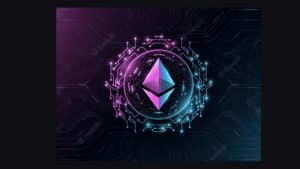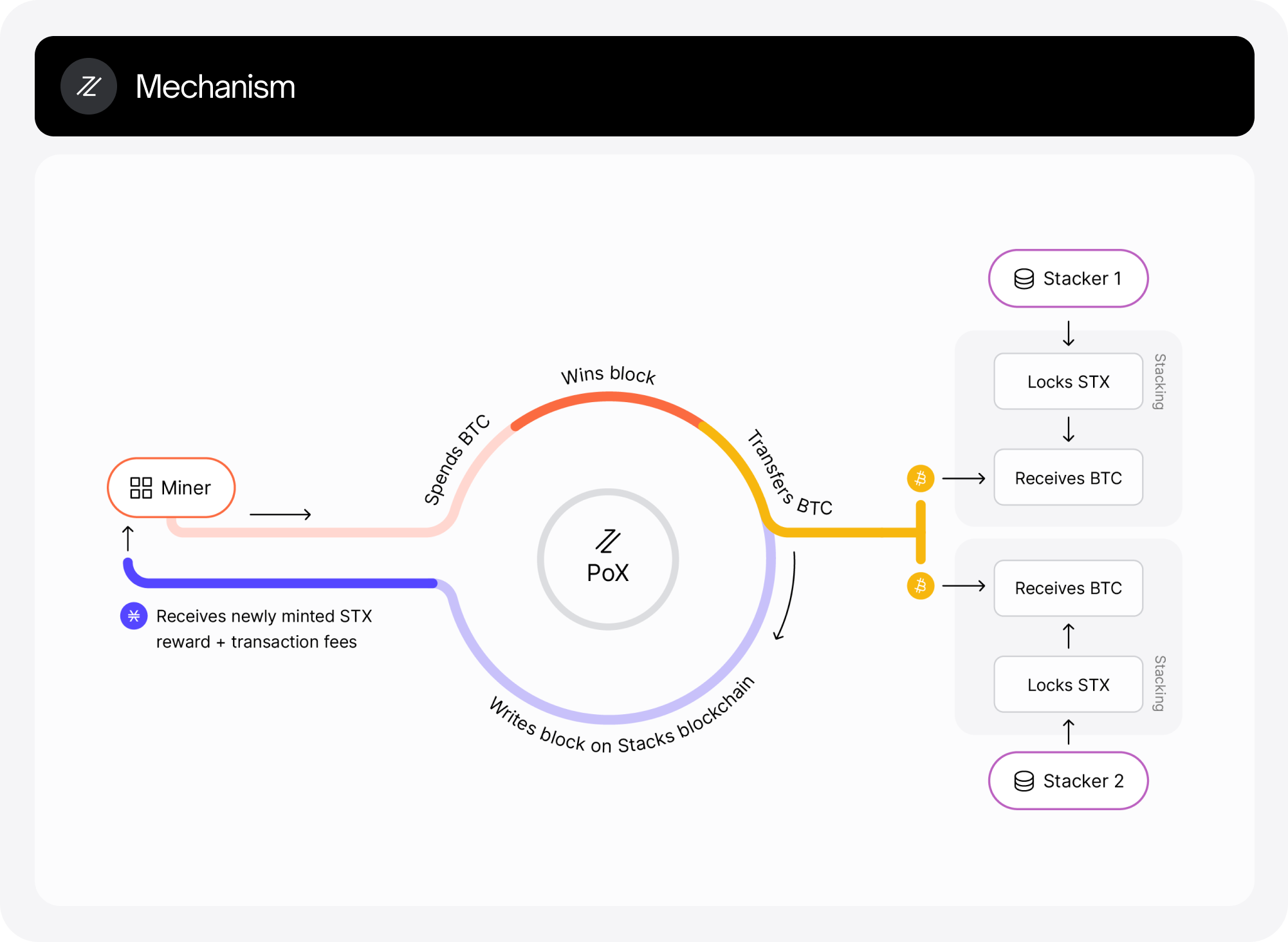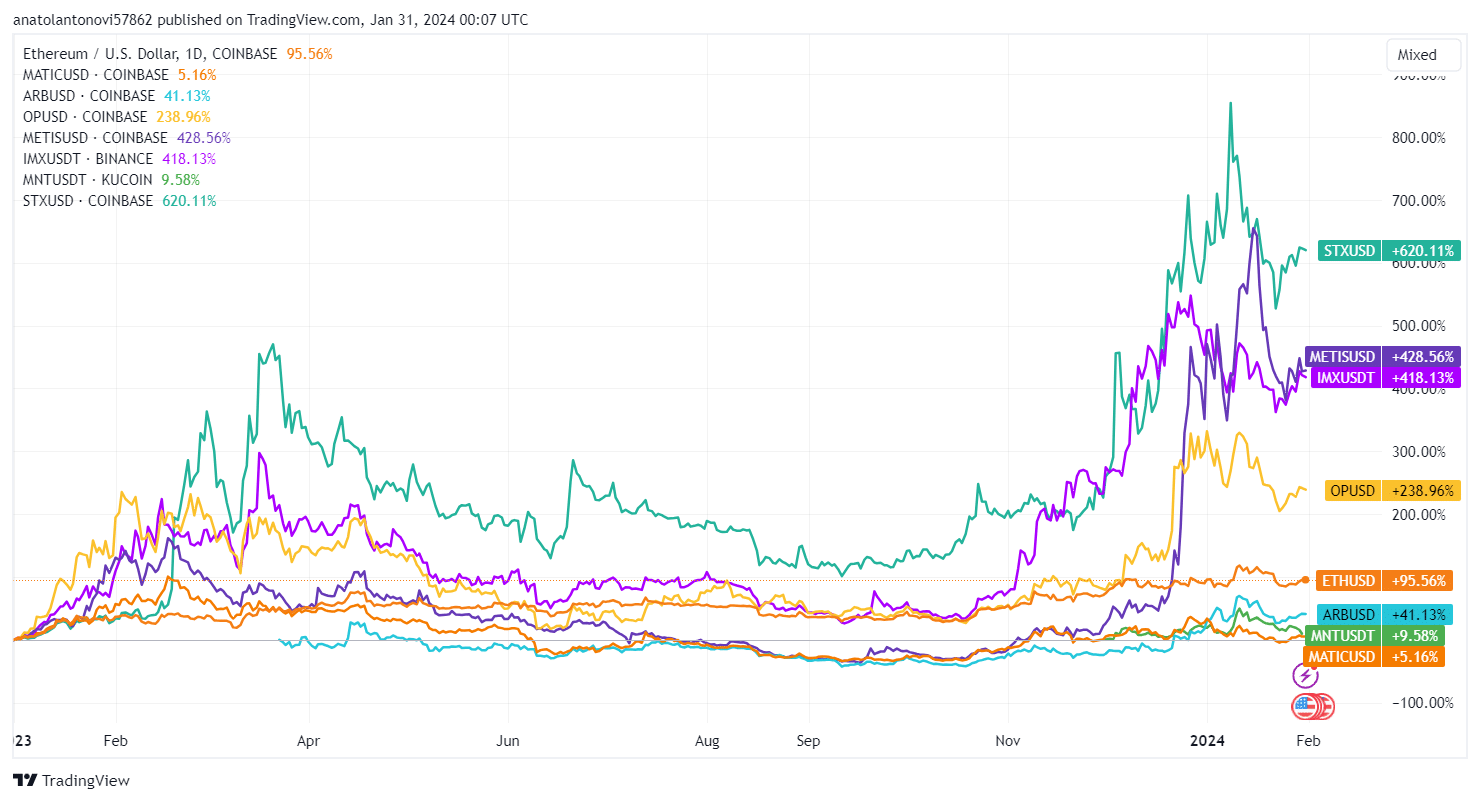Some of the best Layer 2 coins in crypto include Polygon (MATIC), Arbitrum (ARB), Optimism (OP), Metis (METIS), ImmutableX (IMX), Mantle (MNT), and Stacks (STX).
Source: Messari
Written by: Anatol Antonovici | Updated February 1, 2024
Reviewed by: Mike Martin
Fact checked by: Ryan Grace
The layer 2 sector is rapidly evolving to meet the increasing demands of Web3, DeFi, and NFT developers who require scalable solutions that also prioritize user experience. Here are 7 great Level 2 coins to get you started!
Table of Contents
🍒 tasty takeaways
- Layer 2 blockchains are off-chain networks built on a base Layer 1 blockchain, improving its capabilities with greater scalability and transaction processing speed.
- While the majority of layer 2 solutions are designed to scale Ethereum, there are also a few that are developed for Bitcoin.
- Polygon, Arbitrum, and Optimism are the most popular layer 2s.
- Stacks is a fast-growing layer 2 for Bitcoin, using the security of the Bitcoin mainnet to enable smart contract functionality.
Summary
| Token | Symbol | Mainnet | Type |
|---|---|---|---|
| Polygon | MATIC | Ethereum | Sidechain, zk-Rollup |
| Arbitrum | ARB | Ethereum | Optimistic Rollup |
| Optimism | OP | Ethereum | Optimistic Rollup |
| Metis | METIS | Ethereum | Hybrid Rollups |
| ImmutableX | IMX | Ethereum | Zk-Rollup |
| Mantle | MNT | Ethereum | Optimistic Rollup |
| Stacks | STX | Bitcoin | Parallel Chain |
What Are Layer 2 Cryptos?
Layer 2s (L2s) are secondary blockchain networks built on top of an existing blockchain, which we call the mainnet or layer 1 (L1). Their goal is to bring scalability and efficiency to the underlying chain by taking the burden off the mainnet and thus increasing transaction speed and reducing transaction costs.
There are centralized and decentralized L2s, and some of the latter have native coins, which we refer to as layer 2 crypto coins.
Most L2 networks target Ethereum (ETH), which hosts thousands of decentralized applications (dapps) and eagerly needs scalable solutions. However, Bitcoin is also assisted by a few L2s, most of which are centralized.
If you want to get exposure to the layer 2 sector, here are 7 great coins to get you started. 👇
1. Polygon
- Name: Polygon
- Token: MATIC
- Mainnet: Ethereum
- Type: Sidechain, zk-Rollup
Polygon, originally launched in 2017 as Matic, underwent a rebranding in 2023.
It started as an L2 sidechain built on top of Ethereum, but the ecosystem has expanded to include an open-source zk-rollup (zero knowledge) compatible with the Ethereum Virtual Machine (EVM).
A sidechain is a parallel chain with a more efficient consensus mechanism. A sidechain is meant to speed up transactions while still maintaining a connection to the main chain for security and finality of transactions.
However, a drawback is that sidechains tend to be more centralized and less secure compared to Ethereum.
Rollups benefit from the security of the main blockchain while facilitating transactions off-chain.
Polygon Tokens
Polygon’s native token is still MATIC. The ERC-20 token is used for governance, staking, and paying gas fees. As the ecosystem progresses with its rebranding, MATIC is being incrementally converted to POL (Polygon Ecosystem Token) at a 1:1 ratio, a process planned to span over a period of 4 years.
At the time of writing, MATIC is the 14th-largest cryptocurrency with a market cap of $7.8 billion. POL started trading in November 2023 and has a similar price. Currently, it has an $80 million market.
2. Arbitrum
- Name: Arbitrum
- Token: ARB
- Mainnet: Ethereum
- Type: Optimistic rollup
Arbitrum is an L2 chain designed for Ethereum. It uses so-called optimistic rollups, reaching a higher throughput and lower cost than zk-rollups. Optimistic rollups achieve this by assuming transactions are valid by default and processing them in batches off the main chain, with a designated period during which users can challenge and dispute transactions if needed. This process is unique to optimistic rollups.
The Arbitrum ecosystem comprises two L2 chains:
- Arbitrum One is the main network, which runs transactions on the Arbitrum Virtual Machine (AVM) extension that shows compatibility with the EVM. The chain improved its performance with the Nitro upgrade in 2022.
- Arbitrum Nova, while offering greater scalability, this chain is less reliant on Ethereum and, as a result, less decentralized.
Arbitrum is the largest L2 chain by total value locked (TVL) in decentralized finance (DeFi), accounting for almost 5% of the DeFi space.
3. Optimism
- Name: Optimism
- Token: OP
- Mainnet: Ethereum
- Type: Optimistic rollup
Optimism is quite similar to Arbitrum, offering optimistic rollups to scale Ethereum.
Similar to Arbitrum’s AVM, Optimism offers the Optimism Virtual Machine (OVM) extension, which also shows compatibility with the EVM. However, while Arbitrum uses the Stylus feature to let programmers build with C, C++, and Rust, Optimism supports Solidity, designed specifically for Ethereum.
Another difference is that Optimism uses single-round fraud proofs carried out on Ethereum itself instead of multi-round fraud proofs that Arbitrum conducts on its L2.
Optimism’s native token, OP, is a $3+ billion market.
Polygon, Arbitrum, and Optimism are the three largest L2s on Ethereum today.
🍒 5 Fast-Growing Ethereum Layer 2 Projects
4. Metis
- Name: Metis
- Token: METIS
- Mainnet: Ethereum
- Type: Hybrid rollups
Metis is an L2 for Ethereum. Launched in 2021, it is the first L2 using hybrid rollups that merge the speed validation of optimistic rollups with the security of ZK rollups.
Metis is designed for the Web3 ecosystem powering the next-gen dapps.
Additionally, it provides a non-fungible token (NFT) bridge, facilitating the easy transfer of NFTs between its Andromeda network and Ethereum.
In a relatively short period, Metis has attracted some major DeFi crypto projects, including Aave, SushiSwap, and Beefy.
🍒 11 Best DeFi Crypto Projects
The ecosystem is fueled by the METIS token, which offers governance features.
5. ImmutableX
- Name: ImmutableX
- Token: IMX
- Mainnet: Ethereum
- Type: Zk-Rollup
ImmutableX is a scaling solution for Ethereum that focuses on NFTs and Web3 gaming, offering almost zero gas fees and near-instant confirmation for NFT minting and trading.
It leverages StarkEx ZK rollups, which can handle up to 9,000 transactions per second (tps).
It recently introduced an additional chain – ImmutableX zkEVM. Powered by Polygon, it shows compatibility with the EVM.
Source: Immutable
ImmutableX has grown into a broad ecosystem aimed at game developers and NFT creators, comprising SDK tools for game development, NFT minting tools, a wallet solution, and a digital passport, among others.
The IMX token is among the top 40 largest cryptocurrencies.
6. Mantle
- Name: Mantle
- Token: MNT
- Mainnet: Ethereum
- Type: Optimistic rollup
Mantle, launched in 2023, is a relatively new layer 2 project. It uses optimistic rollups and has a modular architecture for better efficiency. It is also compatible with the EVM, enabling developers to build dapps in a low-fee environment.
While developing the project, Mantle joined forces with BitDAO, a decentralized autonomous organization (DAO) meant to support the decentralized ecosystem. Mantle became the first L2 network deployed by a DAO.
BitDAO was known for its huge treasury. Following the merger under the Mantle brand, the resulting ecosystem boasts one of the largest treasuries in the crypto market, valued at over $2 billion. The DAO green-lighted a proposal to allocate $200 million to support early-stage dapps on Mantle.
The ecosystem is fueled by the MNT token, which has been rapidly increasing to a market cap of $1.8 billion.
7. Stacks
- Name: Stacks
- Token: STX
- Mainnet: Bitcoin
- Type: Parallel chain
Stacks is an L2 for Bitcoin. Unlike traditional Bitcoin L2s, such as the Lightning Network, Stacks goes further to expand Bitcoin’s functionality by offering the smart contract feature. Developers use Stacks to build dapps while benefiting from the security of Bitcoin.
Stacks uses the so-called Proof-of-Transfer (PoX) consensus mechanism, which connects to Bitcoin’s Proof of Work (PoW) and involves two groups:
- Miners spend BTC to generate additional ‘Stacks’ of tokens, smart contracts, and transaction fees.
- Stackers support the ecosystem by stacking the native STX tokens and earning BTC.
Source: Stacks
The STX coin surged in popularity at the end of 2023 amid the hype around Bitcoin Ordinals, which are already supported on Stacks.
Layer 2 Coins: Comparison
Here is a brief comparison between the top L2s:
Since the beginning of 2023, Stacks has been the winner in terms of price performance, gaining over 600%.
Source: TradingView
FAQs
Layer 2 networks, or L2s, are secondary frameworks built on top of an existing blockchain (layer 1). The goal of L2s is to enhance scalability and efficiency for the underlying blockchain by offloading some of the computational and transactional demands.
Layer 2 crypto coins are native cryptocurrencies associated with Layer 2 networks. They are used for different purposes, including governance, staking, and transaction fee payments.
Not all layer 2s scale the Ethereum blockchain. There are layer 2 solutions for Bitcoin as well. However, Ethereum attracts the lion’s share of the scaling infrastructure due to its position as the leading smart contract chain, hosting thousands of applications.
The most popular layer 2s are Polygon, Arbitrum, and Optimism. All of these scale Ethereum and play an increasingly important role in the future of decentralized finance (DeFi).
🍒 tasty reads


The Core Blockchain and DeFi Ecosystem: What You Need to Know

7 Best DePIN Crypto Projects

What Is Symbiotic and How Does It Work in 2024?

Ethereum vs Ethereum ETFs – 5 Major Differences


Anatol Antonovici
6+ years of experience writing for crypto brands and blockchain firms, including Coindesk, Cointelegraph, Bitcoinist, CryptoPotato, Algorand, and OTCTrade.com





